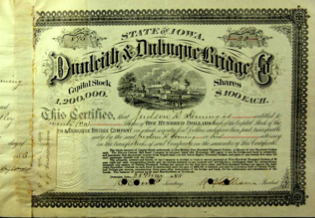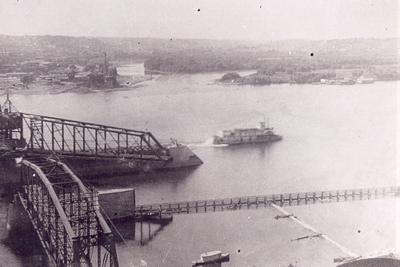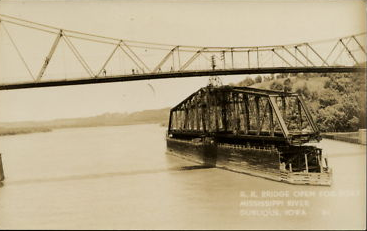Encyclopedia Dubuque
"Encyclopedia Dubuque is the online authority for all things Dubuque, written by the people who know the city best.”
Marshall Cohen—researcher and producer, CNN
Affiliated with the Local History Network of the State Historical Society of Iowa, and the Iowa Museum Association.
DUNLEITH AND DUBUQUE BRIDGE
DUNLEITH AND DUBUQUE BRIDGE. Construction project, also known as the "Railroad Bridge", across the MISSISSIPPI RIVER in the late 1800s. Prior to the construction of the bridge, railroad cars, wagons, and travelers of the 1860s had to be carried across the Mississippi on FERRYBOATS. (1) In the winter, brave men and women walked across the ice from Illinois to Iowa.
Hopes for a bridge across the Mississippi River began in 1857 when the Illinois legislature granted a charter to the Dunleith and Dubuque Bridge Company for the project. (2) Due to the CIVIL WAR, no action was taken on this project.
It was not until 1867 that the Dunleith and Dubuque Bridge Company was reorganized. (3) The first board of directors included William Boyd ALLISON, president; Henry L. STOUT, vice-president and treasurer; and Platt SMITH as one of the directors. All stock in the company was purchased in Dubuque, Boston, and New York.
When the company made application to the City of Dubuque to locate the western end of the bridge and gain right-of-way into the city, many citizens argued that the bridge should also offer a wagon-way or a walk-way. (4) It was even suggested that the bridge company could be given remission of taxes for taking on the additional work. (5) Company officials stated that the matter was out of their hands since their charter had stated that only a railroad bridge would be constructed. (6)
Andrew CARNEGIE of the Union Iron Mills and the Keystone Bridge Company of Philadelphia eventually won the contract. (7) While not the lowest bidder for the work, Carnegie agreed to meet the lowest bid which had been made for the work to be done with cast iron. (8) Carnegie had argued that such a structure would be weaker than wrought iron. He was supported in his argument by Platt SMITH who reported that one of his wagon wheels had been able to break a cast iron street lamp post. (9) Years later in his autobiography Carnegie commented," If you want a contract be on the spot when it is let. A chance remark may give you the prize." (10) Work began on a bridge 1,760 feet long with seven spans and a 359-foot span that allowed river traffic to pass. (11)
The completed bridge was about one-fourth the length of the Golden Gate Bridge near San Francisco. (12) The 146-foot span that rotates, moves on forty cast iron rollers each weighing five hundred pounds. (13) Originally it took six strong men to push a turn-buckle to rotate the 600-ton span each time a boat needed passage. In 1892 the span was wired for electricity and only three men were needed. (14) The power to rotate the bridge in 1987 was supplied by a 30-horse power electric engine. (15) A unique incident occurred to the rotating span on July 9, 1897.
The cost of the bridge was $570,900 considerably less than $1,000,000 anticipated by the bridge officials. (16) The total cost, however, including track laying and approach construction raised the final cost to $1,050,643.49. (17)
A tunnel, blasted through the East Dubuque cliffs provided an approach to the bridge, and rock from the tunnel was used for bridge supports. Pilings for the bridge were driven through the ice and into the stream bed. The work on the bridge was completed in December, 1868 and the first train operated by the DUBUQUE AND SIOUX CITY RAILROAD passed over it.
The bridge was officially opened on New Year's Day, 1869 with the first arrival of a train from Chicago. (18)
It has been suggested that the completion of the bridge stimulated the organization of the DUBUQUE HIGH BRIDGE COMPANY. The success of the railroad bridge indicated to them that a passenger bridge would have at least an equal success. (19)
In 1888, it was announced that the Dubuque stockholders of the railroad bridge had sold their two-thirds interest to the Illinois Central that already owned one-third. (20) The dual ownership had been a source of conflict. While both the Illinois Central and the stockholders had wanted other rail lines to be able to use the bridge, satisfactory terms could not be reached and other railroads were therefore shut out of Dubuque. The Illinois Central quickly began improvements to the bridge. Designed for the use of small steam engines, the bridge was never intended for heavy trains. The marsh area on the Iowa side of the bridge was filled, and the length of the bridge was shortened by 225 feet. The cost was estimated at $200,000. (21)
The Illinois Central held a contract that called for an annual rental of $80,000 to be paid to the stockholders in addition to a fee for each car that crossed the bridge. The railroad, in purchasing the stockholders interest, stated its desire to lower this rate for itself as well as the other railroads that used the bridge. One immediate beneficiary of the new agreement was the Burlington and Northern Railroad that had to use a transfer boat to ferry its cars across the Mississippi.
The bridge today remains generally the same as that which resumed business by 1900.
In 1985 the bridge was purchased from the Illinois Central by the Chicago Central and Pacific Railroad which was headquartered in Waterloo, Iowa. (22) It was the only railroad to use the bridge. It is later operated by Canadian National Railway as a result of their purchase of the Illinois Central in 1999. (Photo Courtesy: http://dubuque-tour.tripod.com)
In 1995 the railroad bridge was a subject of a safety study. According to Roger Wiebusch who studies navigational safety for the U. S. Coast Guard's Second District in St. Louis, Missouri, the Dubuque bridge has the narrowest draw span and the smallest navigational opening on the Mississippi. (23)
---
Source:
1. Kruse, Len. My Old Dubuque, Dubuque, Iowa: Center for Dubuque History-Loras, 2000, p. 90
2. Donovan, Frank P. Iowa Railroads: The Essays of Frank P. Donovan, Jr. Iowa City: University of Iowa Press, 2000 p. 109
3. Donovan, p. 109
4. "Bridge," Telegraph Herald, April 16, 2001, p. 11. Online: http://news.google.com/newspapers?id=Y5VdAAAAIBAJ&sjid=slwNAAAAIBAJ&pg=1594,3824388&dq=dunleith+and+dubuque+railroad+bridge&hl=en
5. "The Pontoon Question," Dubuque Herald, November 2, 1878, p. 4. Online: http://news.google.com/newspapers?id=ZsRCAAAAIBAJ&sjid=WKsMAAAAIBAJ&pg=1538,761477&dq=dunleith+and+dubuque+railroad+bridge&hl=en
6. "A Free Bridge," Dubuque Herald, November 16, 1883, p. 3. Online: http://news.google.com/newspapers?id=0cZCAAAAIBAJ&sjid=YasMAAAAIBAJ&pg=4155,1473875&dq=railroad+bridge+dubuque&hl=en
7. Miller, Jim. "Carnegie Talked His Way into Bridge Contract," Telegraph Herald, February 1, 1973, p. 27. Online: http://news.google.com/newspapers?id=LoVFAAAAIBAJ&sjid=1LwMAAAAIBAJ&pg=5773,287047&dq=dunleith+and+dubuque+railroad+bridge&hl=en
8. Stover, John F. History of the Illinois Central. New York: Macmillan Publishing Company, Inc. 1975, p. 136
9. Donovan, p. 109
10. Miller, Jim.
11. Stover, p. 136
12. Riddell, Amy. "These Men Work Swing Shift Around the Clock," Telegraph Herald, Feb. 24, 1987, p. 48. Online: http://news.google.com/newspapers?id=O5tdAAAAIBAJ&sjid=xlwNAAAAIBAJ&pg=3970,4443738&dq=dubuque+wagon+bridge+opening&hl=en
13. Ibid.
14. Kruse, Len., p. 90
15. Riddell, Amy.
16. "The Construction of the New Bridge Will be in the Neighborhood of $1,000,000," Dubuque Daily Herald, March 20, 1886, p. 4. Online: http://news.google.com/newspapers?id=lj9RAAAAIBAJ&sjid=JdMMAAAAIBAJ&pg=3809,7425618&dq=dunleith+and+dubuque+railroad+bridge&hl=en
17. Donovan, p. 110
18. Stover, p. 136
19. "Here is Picture That Will Awaken Old Time Memories," Telegraph Herald, April 8, 1923, p. 15. Online: http://news.google.com/newspapers?id=OwJIAAAAIBAJ&sjid=88sMAAAAIBAJ&pg=3883,2040784&dq=dunleith+and+dubuque+railroad+bridge&hl=en
20. "Fifty Years Ago Ferry Carried Train Over River," Telegraph Herald, April 1, 1923, p. 15. Online: http://news.google.com/newspapers?id=NgJIAAAAIBAJ&sjid=88sMAAAAIBAJ&pg=3884,1130234&dq=railroad+bridge+dubuque&hl=en
21. "One Span is Taken Out," Dubuque Daily Herald, November 14, 1899. p. 8. Online: http://news.google.com/newspapers?id=EhhBAAAAIBAJ&sjid=cKgMAAAAIBAJ&pg=4895,2533762&dq=railroad+bridge+dubuque&hl=en
22. Riddell, Amy.
23. Eller, Donnelle. "Railroad Bridge Safety Study Slated," Telegraph Herald, April 5, 1995. p. 1. Online: http://news.google.com/newspapers?id=835jAAAAIBAJ&sjid=nXkNAAAAIBAJ&pg=2434,1098423&dq=railroad+bridge+dubuque&hl=en





